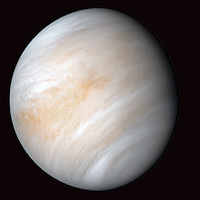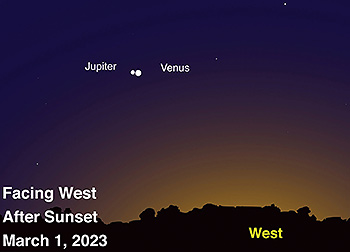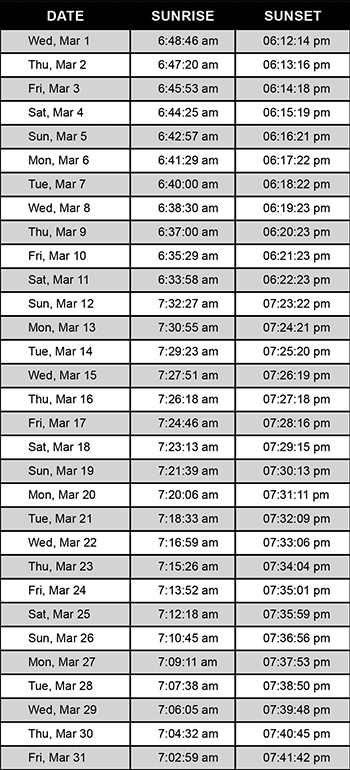|
|
DARK SKY HAPPENINGS - March 2023
Moab
UT (at City Hall)
38O34’ N Latitude
109O33’ W Longitude
4048 ft - 1234 m |
Spot the Morning and Evening Star: Observe Venus
by David Prosper
 Venus is usually the brightest planet in our skies and is called “Earth’s Twin” due to its similar size and its rocky composition. However, Venus is a nightmare version of our planet, featuring a thick, crushing atmosphere of acidic clouds, greenhouse gasses, howling winds, and intense heat at its surface. Venus is usually the brightest planet in our skies and is called “Earth’s Twin” due to its similar size and its rocky composition. However, Venus is a nightmare version of our planet, featuring a thick, crushing atmosphere of acidic clouds, greenhouse gasses, howling winds, and intense heat at its surface.
This rocky inner world’s orbit brings it closer to Earth than any of the other planets. Like Mercury, Venus orbits between our planet and the Sun, so Earth-based observers can observe Venus in the morning before sunrise, or in the evening after sunset – but never high in the sky in the middle of the evening. Since Venus is so striking at twilight, the planet features heavily in sky mythologies. Bright twilight appearances are also the origin of its nicknames: Morning Star and Evening Star. Observers can even spot Venus during the day, if the sky is clear and the planet is bright.
Venus’s other moniker, “Earth’s Twin,” is a bit misleading. In terms of their surface temperatures and atmospheres, they are extremely different! The vast amount of carbon dioxide in the Venusian atmosphere acts as an insulating blanket that retains the Sun’s heat, creating the runaway greenhouse effect. The surface of Venus is a scorching 900° F (482° C). It is even hotter than Mercury despite being millions of miles farther from the Sun. Furthermore, the Venusian surface is a crushing 90 Earth atmospheres on top of its absurd temperatures.

Extreme conditions mean that the mission life of any past Venusian robotic landers were measured in hours at best – and usually minutes! However, conditions in Venus’s upper atmosphere may be much more hospitable. NASA is sending two new missions to Venus by the end of this decade: VERITAS, which will map the surface and study the chemistry of its rocks and volcanoes from orbit, and DAVINCI+, which will study its atmosphere and tectonic surface features via a “descent sphere” that will plunge into Venus’s clouds. Follow their development and discover more about Venus at solarsystem.nasa.gov/venus.
Venus and Jupiter continue to move closer together in the evening sky this month. Jupiter will continue its descent towards the horizon while Venus will continue to climb and will be visible in the evenings though mid-summer of 2023. It’s a great year for Venus fans!
Image created with assistance from Stellarium
The top layers of Venus’s cloud pop in this contrast-enhanced image, reprocessed with modern techniques from Mariner 10 data.
Credit: NASA/JPL-Caltech
Source: https://solarsystem.nasa.gov/resources/2524/newly-processed-views-of-venus-from-mariner-10/
This article is distributed by NASA’s Night Sky Network (NSN). The NSN program supports astronomy clubs across the USA dedicated to astronomy outreach. Visit nightsky.jpl.nasa.gov to find local clubs, events, and more!
Sunrise-Sunset
(The time of sunrise and sunset assumes a flat horizon. Actual time may
vary depending upon the landscape.) |
 |
MOON HAPPENINGS
Mar 7- Full Moon at 5:40am
Mar 14 - Third Quarter at 8:08am
Mar 21 - New Moon at 11:33am
Mar 28 - First Quarter at 8:32am
|
Moab Dark Skies mission is to promote the appreciation and conservation of Moab’s valuable and rare dark skies. Moab Dark Skies was established by the Friends of Arches and Canyonlands Parks in conjunction with the National Park Service and Utah State Parks Division of Natural Resources
For more information, check out our Facebook page. |
|
|
|
|
|
|
|
© 2002-2024 Moab Happenings. All rights
reserved.
Reproduction of information contained in this site is
expressly prohibited.
|
|